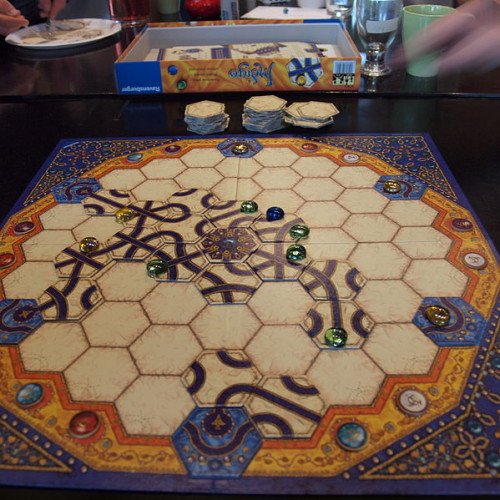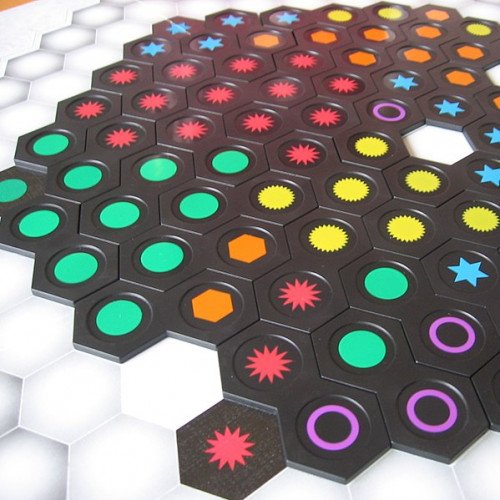"INDIGO" vs "INGENIOUS"

INDIGO
Indigo is a 2012 board game developed by Reiner Knizia and published by Ravensburger. Indigo is a game for two to four players. The idea of the game is to collect jewels from the board by laying tiles. The board takes the form of a hexagonal grid, with one tile present at the centre and six at the edge, with even intervals. The rest of the board is empty. On the centre tile are six jewels: one sapphire and five emeralds. The six tiles at the edge have one topaz each. The edges of the board between the tiles with topazes are marked with the players' colours. Depending on the number of players, a player can either have an edge all to his/her own, share an edge with another player, or both. On a player's turn, he/she places a tile anywhere on the board. The tiles have paths on them. If the tile touches another tile's edge having a jewel on it, the jewel travels along the formed path, only stopping when it hits empty space, the board's edge, or another jewel. A jewel reaching the board's edge is removed from play, becoming the property of the edge's owner. If the edge is shared between two players, one player gets the jewel and the other gets a duplicate jewel from storage. If two jewels collide, both are removed from play, not becoming any player's property. On the centre tile, the sapphire may only be moved after all five emeralds are already in play. The game ends when no jewels remain on the board. Then the players' jewels are scored. A sapphire awards 3 points, an emerald 2 points, and a topaz 1 point. The player with the most points wins.
Statistics for this Xoptio

INGENIOUS
Ingenious is the English name for Einfach Genial (Simply Ingenious), a German abstract strategy board game designed by Reiner Knizia under commission from Sophisticated Games and published in 2004 by Kosmos. Across most of Europe it is titled as the local translation of Ingenious or Simply Ingenious, the notable exception being Mensa Connections in the UK. The game can be played by two, three or four players, with additional rules provided for solo and four-player partnership play. Each player has a rack of six randomly chosen tiles which are concealed from the other players. The board is also made up of a number of hexagons, with the two outermost rings reserved for three- and four-player games respectively. The rules state that the youngest player takes the first turn, although where multiple games are played it is common practice for the first turn to rotate clockwise around the board in subsequent games. Players take turns placing a tile on the board, scoring points by creating lines of identically colored hexes. On the first turn, each player must place a tile next to a different one of the six printed colored symbols on the board; thereafter players may place tiles on any free space. If a player reaches a score of 18 with any colour, they declare 'Ingenious', 'Genial' or 'Mensa' (depending on which language version they are playing) and place a further tile. Achieving a score of 18 on two colours at the same time will earn two bonus plays, and bonus plays may earn further bonus plays by reaching 18 points on another colour. Once a player has used their bonus play for any colour, they will not score additional points or earn further bonus plays on that particular colour. All bonus plays are made from the player's current rack of tiles. Bonus plays must be used immediately.